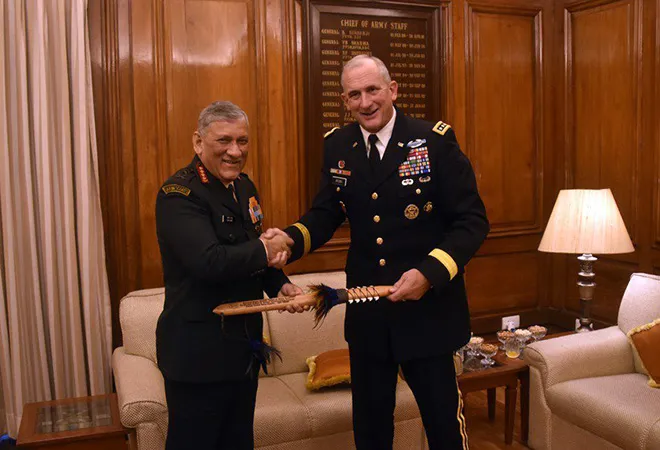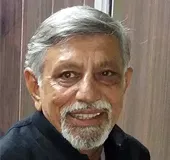
Donald Trump’s administration, post his anti-Pakistan tweet on New Year’s Day, has begun applying pressure on Pakistan to act against the Taliban and Haqqani network. Hardly a day goes by without comments from a member of his administration conveying in strong terms that it expects Pakistan to act. Simultaneously, the US has commenced launching drone strikes on the Pakistani soil. The number of strikes is likely to increase. To add to Pakistan’s woes, the US has officially authorised its military commanders in Afghanistan to target terrorist camps and hideouts in both Afghanistan and Pakistan.
With an increase in terrorist strikes in Afghanistan, pressure would only increase. The recent attack on the Intercontinental Hotel in Kabul and the ambulance blast had hallmarks of Pakistan’s direct involvement. The Afghan government conveyed the same to Pakistan with proof, including phone taps involving recent attacks. This added to the pressures on Pakistan.
India, on the other hand, is relentless in its actions along the LoC. It continues to respond to Pakistan’s provocations in full measure. Its surgical strike and other smaller cross border strikes indicate that it is willing to up the ante. It has begun retaliating heavily to Pakistan’s ceasefire violations.
Pakistan’s denials of the surgical and cross border strikes are indicative of Pakistan being wary to respond, knowing India may hit back harder. It has, however, continued to push militants across the border and keeping the LoC active, thus continuing with its policy without respite, banking on its nuclear deterrence.
Indian army chief, General Bipin Rawat, openly challenged Pakistan’s so-called nuclear threats, when he stated that if tasked by the government, the army is prepared to cross the border into Pakistan and call its nuclear bluff. It compelled Pakistan to respond with challenges and threats. However, it gave Pakistan an uncomfortable feeling that India may again seriously consider the ‘cold start’ doctrine, which it has professed and regularly practised as part of its exercises, but never openly admitted. Thus, it continues to fear Indian counter-strikes.
Within Pakistan, the army is divided between two frontiers, Eastern and Western. On its Eastern front with India, it does not expect induction of militants, hence maintains a lesser strength, yet Indian response must ensure levels of alertness as also enhanced firepower. It suffers regular casualties due to Indian actions. On its Western front, where there are strikes by the Baluch Freedom Movement fighters and the TTP, and the army is involved in battling militancy. It is facing pressure and losses from both directions, yet hides its figures, fearing impact on the morale of its forces and the nation. The declaration of casualties would damage its image of invincibility.
Internally Pakistan remains a divided nation. The control of the military, supported by the judiciary, has ensured that no political leader questions the army or its strategic intent. Neither can any party profess peace talks with India or curb the power of the deep state. The strong man, Nawaz Sharif, is out of reckoning and his party heading the government is under threat from multiple quarters. This being the election year, there is a likelihood of religious and fundamental parties being a part of the future government. Whoever forms the government will have to toe the military line.
International pressure also continues to mount on Pakistan to curb supporting terror groups. The next meeting of the Financial Action Task Force (FATF) is scheduled for next month in Paris. India, backed by Russia and the US, are expected to make a strong pitch for the world body to compel Pakistan to step up its fight against terror funding. China would attempt to shield Pakistan but may not succeed.
Pakistan thus would try to wriggle its way out, seeking a face saving yet safe passage through this mess. An analysis of the situation from Pakistan’s angle would suggest limited options available to it. It would historically consider India’s strong response along the LoC and conventional military action as it biggest threat, as it has no plans for talking peace with India.
Hence, would never consider compromising on its anti-India stance. Thus, anti-India terror groups would continue getting requisite support. Its Kashmir policy, guided by its military, would not change anytime soon. The LoC would continue remaining hyper active.
It may delay action against the Taliban and Haqqani network for now, hoping the US considers giving priority to talks with them. It is presently hoping that the US would realise that it needs the support of Pakistan’s Karachi port and air space and can only push Pakistan thus far and no further. Hence, it continues to make statements on no bases and promises to act on concrete inputs yet does nothing.
It is fearful of taking on the Taliban and Haqqani network directly for multiple reasons. First, in its view, it would shift the battle in Afghanistan into Pakistan territory and involve its army, which is already under intense pressure. Second, it could lead to them joining hands with anti-Pakistan groups, the TTP and JuA, making it disastrous for Pakistan itself. Finally, if it does take them on and eliminates a few leaders and the group is compelled to go in for negotiations, then Pakistan would never be able to consider Afghanistan as its strategic depth. It would remain ignored by them, even if they become part of the government.
It may be willing to undertake actions against the IS directly and restrict the Taliban and Haqqani network from enhancing its operations, provided the US engages the TTP and its affiliates alongside the Baluchistan Liberation Army. It may even offer to bring the Taliban and Haqqani leadership to the negotiating table. This is possibly Pakistan’s Afghan policy.
In summary, while it may be willing to negotiate with the US for Afghanistan, it would never compromise on its anti-India policy. By adopting this approach, it may be able to undermine world pressure and enable it to continue with its anti-India stance, which it considers as it biggest threat. Unless its bluff is called, and pressure enhanced, it would take the US and the west for a ride, without changing anything on the ground.
For India, solely mounting pressure along the LoC may bring satisfaction to the troops deployed and the nation but would not curb Pakistan’s actions. Unless the losses are made visible to the Pak public and escalated to the level that Pakistan realises that it is the loser, it would not change. India possesses the firepower and determination to act, ignoring Pakistan’s threat, hence must be willing to up the ante.
Its counter actions should be such that it adds to Pakistan’s pressures of its western front. It has been done before and should be repeated. Employment of artillery to strike deep, without considering collateral damage, should be the immediate action, alongside the diplomatic pressures on Pakistan to act. Only if cornered on both fronts with equal pressure and increased losses to its forces, would it see sense and possibly respond. Otherwise, the current trend would continue unabated and both India and Afghanistan would continue to witness Pakistan sponsored violence.
The views expressed above belong to the author(s). ORF research and analyses now available on Telegram! Click here to access our curated content — blogs, longforms and interviews.




 PREV
PREV


